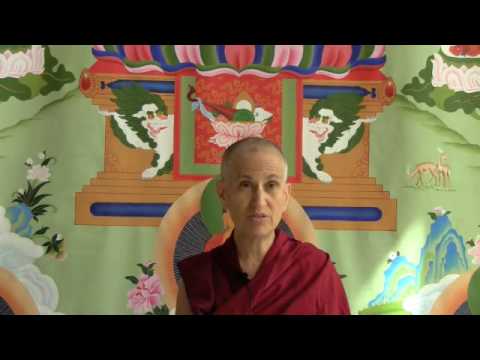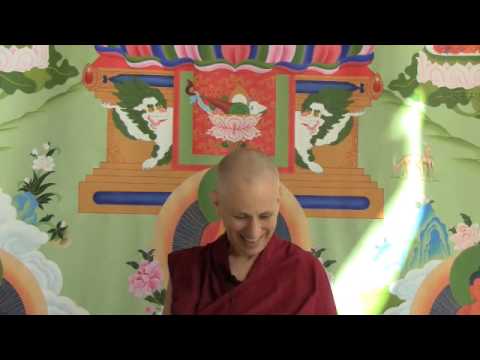Sangha refuge
Stages of the Path #60: Refuge Ngöndro Part 9
Part of a series of short talks on the preliminary practice (ngöndro) of taking refuge.
- It’s the Ārya Sangha that we take refuge in
- How to visualize the Sangha as the object of refuge
- Purifying wrong view in relation to the Sangha
Stages of the Path 60: Sangha refuge ( download)
We’ll continue talking about how to do the refuge practice. We’ve talked about refuge to the guru, the Buddha, the Dharma, and so today’s the Sangha. Remember when we’re taking refuge in the Sangha, it’s the Ārya Sangha, those beings who have direct perception of emptiness. Those are the real object of refuge—and a community of four or more fully ordained people is a representative of that. But our actual object of refuge is people who have the realization and particularly the true paths and true cessations in their mindstreams. That’s what we’re taking refuge in for the jewel of Sangha.
When we’re doing the refuge in the Dharma practice, then you imagine the light and nectar coming from all the texts that you visualized that are all around all the great masters and all the Buddhas. That’s where the light comes from.
When we take refuge in the Sangha, the light comes from the bodhisattvas, from the solitary realizer arhats, the hearer arhats, the ḍākas, ḍākinīs, and the Dharma protectors. Light and nectar come from all of them into us and into all the beings around us. When it’s first the white light, then we think that it’s purifying the negativities we’ve created in relationship to the Sangha, such as criticizing the Sangha, misappropriating their belongings, stealing from them, all sorts of things like that. It might all seem kind of unreal, like “Well, who would do that?” But you look at the PLA soldiers, when they went into the Chinese and Tibetan temples and destroyed many things. They stole from the Sangha and forced the Sangha to disrobe. That kind of negative karma we could have created in previous lives. If you’re with a Sangha community, using things that belong to the Sangha without asking permission or misusing things so that the Sangha property gets consumed too soon or it gets destroyed, all those kinds of things create some negativity with the Sangha. So we want to think that all of that is getting purified.
Another thing it mentioned here is when somebody wants to donate to the Sangha, you say, “Oh, you don’t need to give that much.” We shouldn’t say that. If somebody in their mind already has something that they want to donate, then we shouldn’t say, “Oh, you shouldn’t give, that’s too much,” or whatever because it prevents that person from creating the good karma from doing it and maybe the Sangha does need that.
We want to imagine purifying all the negativities we’ve created in relationship with the Sangha—making fun of them, ridiculing them, who knows what. We do all sorts of things. When the golden light comes, think of the realizations of the Sangha and particularly the bodhicitta, the realization of emptiness, of the four noble truths and so on. Think that all that comes into us in the form of golden light and fills us and it fills all the sentient beings around us. We think that we’ve received the qualities of the Sangha and while doing this we’re reciting “Namo Sanghaya,” or “I take refuge in the Sangha.”
Venerable Thubten Chodron
Venerable Chodron emphasizes the practical application of Buddha’s teachings in our daily lives and is especially skilled at explaining them in ways easily understood and practiced by Westerners. She is well known for her warm, humorous, and lucid teachings. She was ordained as a Buddhist nun in 1977 by Kyabje Ling Rinpoche in Dharamsala, India, and in 1986 she received bhikshuni (full) ordination in Taiwan. Read her full bio.


